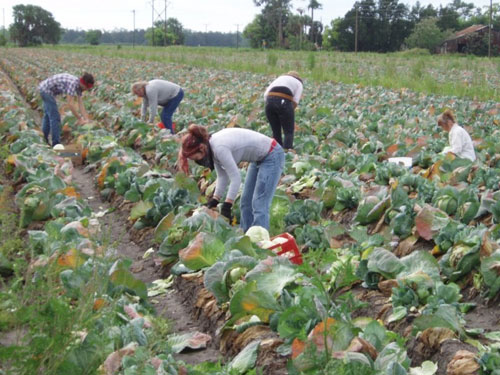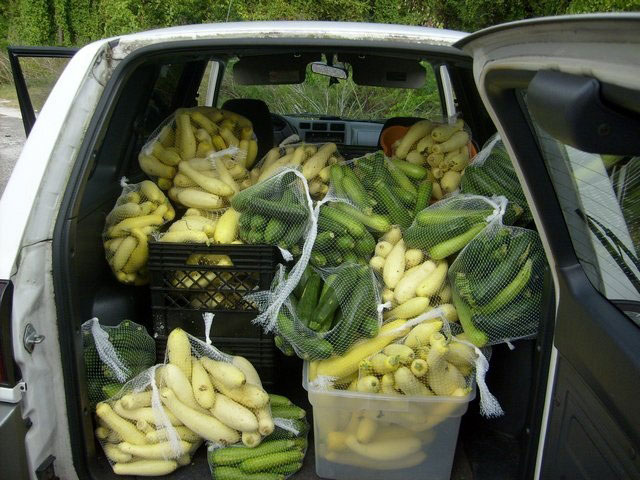
By Haley M. Walker | hwalker@flagler.edu
Sandi Newman knows that appearance isn’t everything.
On Saturday mornings, she travels to farms across Northeast Florida. She gathers crops that are considered not physically adequate for commercial purposes or what is left behind after a harvest. Newman is the Area Coordinator for the Society of St. Andrew, a Christian ministry that specializes in this process, commonly known as “gleaning.” The organization collects food that would otherwise go to waste from farms nationwide and distributes it to feed the hungry.
“We often harvest commercial crops after the mechanical equipment has gone through and left produce on the ground, or we pick crops that were not commercially viable,” Newman said. “For example, we picked a field of sweet onions last year in Elkton, near Hastings, that had grown double, not the single round onion that could be sold commercially at Publix.”
Gleaning is a process performed throughout civilizations for centuries. It has been depicted in art dating back to the 1800s, and many consider the act as having direct ties to the Bible. Today, however, many use gleaning as a way to provide produce to local churches, homeless shelters, soup kitchens and food banks.
“We provide fresh, nutritious food to agencies serving the poor at no cost to them, which helps them stretch their already tight budgets,” Newman said. “Thousands of pounds of food are wasted because it never is harvested, or is culled (chosen) at the farm before packing. Our gleaners pick in the fields of commercial farms, we gather produce from the cull line at farms, and we load our trucks from farms who are clearing out their coolers of unsold produce that would normally be thrown out.”
According to the U.S. Department of Agriculture, 96 billion pounds of food go to waste each year. This translates to more than 250 million pounds every day. The USDA has also reported that close to 36 million people, or approximately 11 percent of households in the United States suffer from some form of hunger.
Flagler student and gleaning volunteer, Molly Jane Hammond, is no stranger to the truth of these facts. She has been “dumpster diving” with Food Not Bombs for three years and recently started gleaning.
“The amount of food wasted in the United States is appalling,” Hammond said.
“Gleaning really opened my eyes to the larger, even more dire reality: exponentially greater amounts of food are wasted right on the vine, at the point of production.”
Volunteer Carol Green said she worries about hunger in America, as she feels the gap between rich and poor will continue to grow wider.
“We are living on 1998 wages and paying 2008 prices,” Green said. “People are falling through the cracks.”
The Northeast Florida chapter of the Society of St. Andrew currently uses gleaning to serve 25 organizations throughout Duval, Flagler, St. Johns and Putnam counties.
Hammond and the local Food Not Bombs collective have been using gleaning to provide vegetarian meals to the homeless for approximately a year. She described how the organization served cabbage all week when she and the other volunteers brought home more than 2,500 pounds after one gleaning.
Throughout the year, the Society of St. Andrew organizes gleaning projects across Northeast Florida as the seasons and harvests change. According to Newman, citrus is typically harvested during the winter, broccoli and cabbage during February and March, onions in April and May and potatoes in the summer.

“I feel blessed to work with the volunteers that show me every day true caring and commitment,” Newman said. “There is a wonderful network of caring individuals that work tirelessly to serve others, and I enjoy locating and working with them to provide fresh produce and fruit.”
Terry Buckenmeyer, another St. Augustine volunteer, said that the projects help not only those receiving the food, but they bring a variety of benefits to those participating as well.
“It is so good to make connections with people and share a common purpose in improving a community we all care about,” Buckenmeyer said. “This is a chance for us to take care of each other.”
Newman and the Society of St. Andrew are beginning to transition out of the winter’s citrus harvests into broccoli and cabbage. The organization plans to continue to recruit volunteers and be in the field each week.
“I feel strongly about the waste of food when folks go hungry, and feel fortunate that there is something I can do right here in my community,” Newman said. “I can’t imagine not being involved in some way for the rest of my life.”


Be the first to comment on "Locals gather crops for good cause"